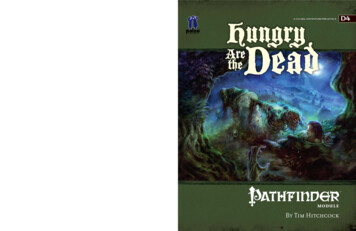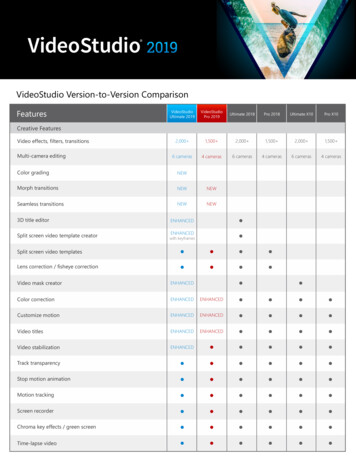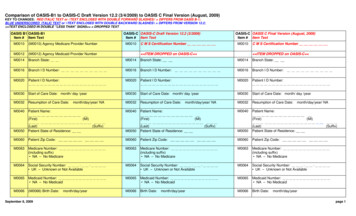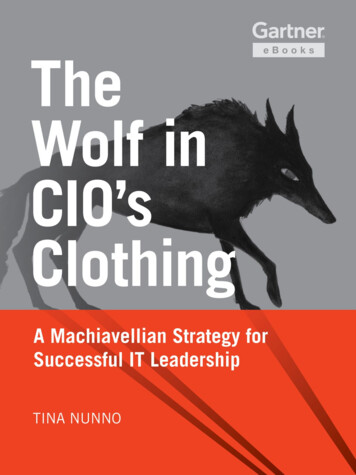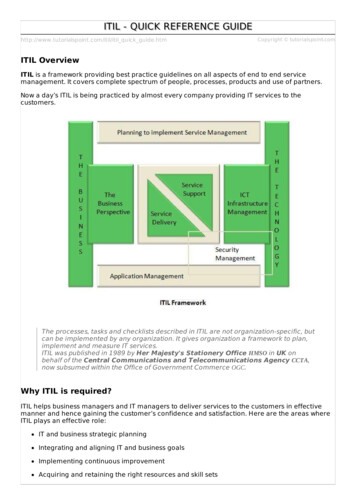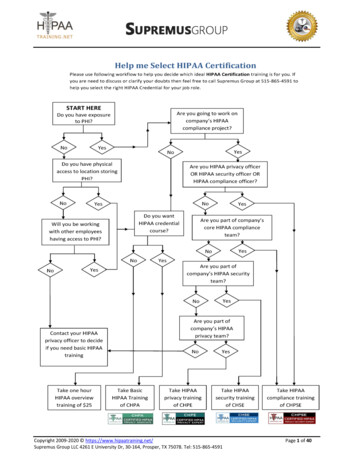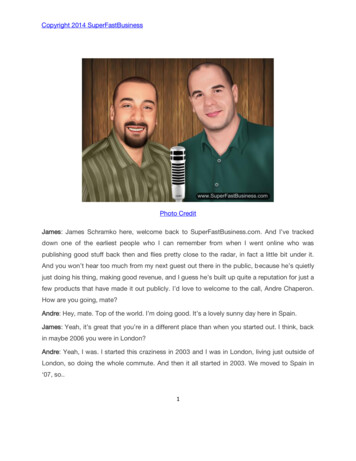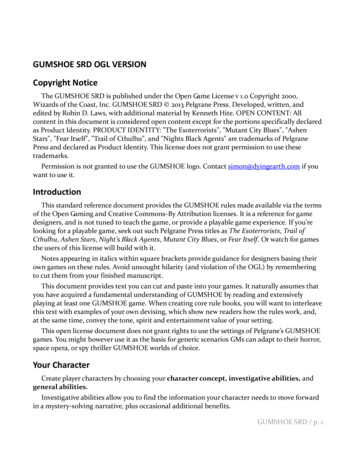
Transcription
GUMSHOE SRD OGL VERSIONCopyright NoticeThe GUMSHOE SRD is published under the Open Game License v 1.0 Copyright 2000,Wizards of the Coast, Inc. GUMSHOE SRD 2013 Pelgrane Press. Developed, written, andedited by Robin D. Laws, with additional material by Kenneth Hite. OPEN CONTENT: Allcontent in this document is considered open content except for the portions specifically declaredas Product Identity. PRODUCT IDENTITY: "The Esoterrorists", "Mutant City Blues", "AshenStars", "Fear Itself", "Trail of Cthulhu", and "Nights Black Agents" are trademarks of PelgranePress and declared as Product Identity. This license does not grant permission to use thesetrademarks.Permission is not granted to use the GUMSHOE logo. Contact simon@dyingearth.com if youwant to use it.IntroductionThis standard reference document provides the GUMSHOE rules made available via the termsof the Open Gaming and Creative Commons-By Attribution licenses. It is a reference for gamedesigners, and is not tuned to teach the game, or provide a playable game experience. If you’relooking for a playable game, seek out such Pelgrane Press titles as The Esoterrorists, Trail ofCthulhu, Ashen Stars, Night’s Black Agents, Mutant City Blues, or Fear Itself. Or watch for gamesthe users of this license will build with it.Notes appearing in italics within square brackets provide guidance for designers basing theirown games on these rules. Avoid unsought hilarity (and violation of the OGL) by rememberingto cut them from your finished manuscript.This document provides text you can cut and paste into your games. It naturally assumes thatyou have acquired a fundamental understanding of GUMSHOE by reading and extensivelyplaying at least one GUMSHOE game. When creating core rule books, you will want to interleavethis text with examples of your own devising, which show new readers how the rules work, and,at the same time, convey the tone, spirit and entertainment value of your setting.This open license document does not grant rights to use the settings of Pelgrane’s GUMSHOEgames. You might however use it as the basis for generic scenarios GMs can adapt to their horror,space opera, or spy thriller GUMSHOE worlds of choice.Your CharacterCreate player characters by choosing your character concept, investigative abilities, andgeneral abilities.Investigative abilities allow you to find the information your character needs to move forwardin a mystery-solving narrative, plus occasional additional benefits.GUMSHOE SRD / p. 1
General abilities help you survive while you’re gathering information and solving problems.You create characters by spending build points on your character’s abilities. Each ability has anumerical rating. Every rating point costs 1 build point to purchase.The GUMSHOE rules define your character by what he or she can accomplish in aninvestigative scenario. The component elements of each ability don’t matter in rules terms. Therules don’t care if your Forensic Accounting ability is one part native mental acuity to two partstraining or vice versa, although you can mention them when describing your character to others.All that matters is how you solve cases, and overcome other obstacles arising from them.Ratings and PoolsThe number you assign to each ability is called a rating. Although you may improve themgradually over time, ratings remain static over the course of the typical game session.For each ability your character has a pool of points, which fluctuates over the course of eachsession. You begin each case, or scenario, with pool points equal to your rating. You might thenimmediately spend some of them during a prelude phase to the investigation itself. You willdefinitely spend points as you conduct the investigation. At times your pool may increase,sometimes refreshing to equal its rating again.The distinction between ratings and pools is a crucial one; keep it in mind as you read andinterpret the GUMSHOE rules.Step One: Concept[Describe the sorts of mystery-solving characters the players will play in your setting, and anypreliminary creative decisions each player will make about her character.]Stereotypes[In some games you may wish to guide players to choose genre-appropriate concepts bysupplying a list of stereotypes as a starting point in character creation.]Sample Stereotype: Good GirlThe good girl is an ordinary young woman. If not chaste, she's more modest and circumspectabout her sexuality than the other young women in the cast of characters. Smart and cautious,she becomes the ultimate prize of the shadowy forces stalking the group—often proving herselfmore determined to survive than those around her.[From Fear Itself]Packages[In some games you may choose to give additional mechanical heft to the stereotypes byturning them into Packages.]Each package sets out minimum requirements in both Investigative and General abilities.Before spending any points elsewhere, make sure you have those covered.GUMSHOE SRD / p. 2
Sample Package: Communications Officer (Hailer)You establish, receive and route communications with other ships, planetary installations, andspace stations. More than a glorified space receptionist, you serve as a combination of publicrelations frontperson and psychological warrior. You facilitate the decision-making process ofthe crew and convey its intentions to the outside world. In crisis situations, you keep vitalinformation flowing to the stratco, so that the right decisions get made at lightning speed.During space combat, you launch hack attacks on the enemy’s computer system, while defendingyour own from penetration.Investigative: Linguistics 1, Flattery 1, Reassurance 1, Decryption 1, Data Retrieval 1General: Communications Intercept 6, Sense Trouble 4[From Ashen Stars]Occupations[A variant of the Package sub-system, the Occupation, appears in Trail of Cthulhu. Rather thanproviding minimums to qualify for a package, an Occupation provides key abilities at half-price,and often a Special mechanical benefit as well. Future Pelgrane GUMSHOE designs will likely stickto the faster, simpler ability minimum approach found in Packages.]You get two rating points in Occupational abilities for every one build point you spend. Forexample, 12 rating points of Occupational abilities cost you 6 build points. Left over half-pointsare lost, so assign an even number points to Occupational abilities.Sample Occupation: Private InvestigatorThere are things that cops can’t do, and things that cops won’t do, and you’ll take money to doeither. Sometimes you get dragged into something the cops want you out of, but you gotta stay init to keep the cops honest. What keeps you honest? Now, that’s the real mystery, ain’t it?Occupational Abilities: Accounting, Disguise, Driving, Law, Locksmith, Photography, AssessHonesty, Reassurance, Scuffling, Shadowing.Special: Private eyes with point pools in Disguise or Shadowing may spend points after rollingthe die for a test. For every 2 points you spend after rolling the die, you increase the die result by1. This only applies if you are undistracted and not directly observed. It never applies during acontest. You must describe the thing that almost went wrong, and how you caught it barely intime or succeeded through sheer luck.[From Trail of Cthulhu]Step Two: Assign Investigative AbilitiesInvestigative abilities are central to any GUMSHOE character; they enable you to gatherinformation and drive the plot forward. The number of points each player spends oninvestigative abilities varies according to the number of regularly attending players, according tothe following table. The GM leads the group through the list of investigative build points,ensuring that each one of them is covered by at least one member of the group.GUMSHOE SRD / p. 3
[Complete this chart with values based on the total number of investigative abilities you includein your game. That number is x. The final numbers don’t have to be dead on, so fudge themupwards if desired for a prettier-looking numerical progression.]# of playersInvestigative Build Points280% of x360% of x455% of x5 50% of xPlayers who can only attend every now and then get the same number of investigative buildpoints as everyone else, but are not counted toward the total when deciding how many points toallocate.Free Rating[If your setting concept assumes all characters will have a particular ability (like Cop Talk ifeveryone is a police officer), indicate what it is, and that everyone gets 1 rating point in it for free.]What Good Are Investigative Ratings?Players used to the bumbling half-competence of their characters in other investigative gamesystems may be surprised to learn how effective even a single rating point is.Any rating in an investigative ability indicates a high degree of professional accomplishmentor impressive natural talent. If you have an ability relevant to the task at hand, you automaticallysucceed in discovering any information or overcoming any obstacles necessary to propel youfrom the current scene further into the story.You may ask to spend points to gain special benefits. Sometimes the GM will offer you thechance to spend points. In other circumstances she may accept your suggestions of ways to gainspecial benefits. Use them wisely; spent points do not return until the next investigation begins.Once all of the abilities are covered, you are permitted, if you desire, to reserve any remainingbuild points to spend as situations arise during play. You may assign yourself additional abilities,or increase your ratings in the ones you’ve chosen, as seems appropriate to your character and thesituations she finds herself in. When you choose to do this, you are not suddenly acquiringabilities on the spot, but simply revealing for the first time what the character has been able to doall along.If you want, you can save build points from character creation to spend later. If your GM isrunning an ongoing series, you will accumulate additional build points during play.Investigative BenchmarksWhen choosing investigative abilities it is better to get a large number of abilities with fairlylow ratings. Even a 1-point rating is worth having. You’ll rarely want to spend more than 3 or 4GUMSHOE SRD / p. 4
points on any one investigative ability.You must have an investigative ability at a rating of at least 1 to get useful information from it.Step 3: Assign General AbilitiesEach player gets 60 points to spend on general abilities, regardless of group size.General abilities use different rules than investigative ones, which allow for possible failure.They help you survive while you investigating. When choosing general abilities, you’ll want toconcentrate your points among a few abilities, giving your comparatively higher ratings than youwant in the investigative category.[To support 60 as the value for general build points, include approximately 12 broadly usefulgeneral abilities. Some games may also support specialized general abilities on top of the 12. Youmay wish to assign an additional build pool to another class of general abilities unique to yoursetting.]You start the game with 1 point [each] in Health and [any other similar ablative ability requiredfor the setting’s genre emulation, like Stability in most GUMSHOE horror games.]Although there is no set cap on abilities, the second highest rating must be at least half that ofthe highest rating.What Good are General Ratings?General abilities use a different set of rules and are measured on a different scale thaninvestigative abilities. The two ability sets are handled in different way because they fulfilldistinct narrative functions. The rules governing general abilities introduce the possibility offailure into the game, creating suspense and uncertainty. Uncertain outcomes make scenes ofphysical action more exciting, but can stop a mystery story dead if applied to the collection ofinformation. This division may seem aesthetically weird when you first encounter it, but as yougrow used to the GUMSHOE system you’ll see that it works.GUMSHOE focuses not on your character’s innate traits, but on what they can actually do inthe course of a storyline. Why they can do it is up to each player. Your characters are as strong,fast, and good-looking as you want them to be.General Ability BenchmarksA rating of 1-3 indicates that the ability is a sideline. 4-7 is solid but not off the charts. 8 ormore suggests a dedicated bad-assery that will be immediately apparent to observers when theysee you in action.0-Rated General AbilitiesIf you have a rating of 0 in a general ability, that is you have put no build points into it, youcannot make a test on that ability. That is not to say you can't do the thing at all; it's only if youwant to attempt something requiring a roll that you will not succeed. You character might be ableto drive, but with a Drive rating of 0 you will not be able to deal with a car chase or potentialcrash.GUMSHOE SRD / p. 5
Investigative AbilitiesThe following abilities are the bread and butter of GUMSHOE characters.Ability descriptions consist of a brief general description, followed by examples of their use inan investigation. Creative players should be able to propose additional uses for their abilities asunexpected situations confront their characters.Certain specific actions may overlap between a couple of abilities. For example, you canenhance image resolution with either Data Retrieval or Photography.Some abilities, like Research, are broadly useful, and will crop up constantly. Others may becalled for many times in the course of one scenario, and not at all in others. When building yourcharacter, strike a balance between the reliable workhouse abilities and their exotic, specializedcounterparts.Investigative abilities are divided into the following sub-groups: Academic, Interpersonal, andTechnical. The purpose of the sub-groups is to allow you to quickly find the best ability for thetask during play, by scanning the
Free Rating [If your setting concept assumes all characters will have a particular ability (like Cop Talk if everyone is a police officer), indicate what it is, and that everyone gets 1 rating point in it for free.] What Good Are Investigative Ratings? Players used to the bumbling half-competence of their characters in other investigative game systems may be surprised to learn how effective .
